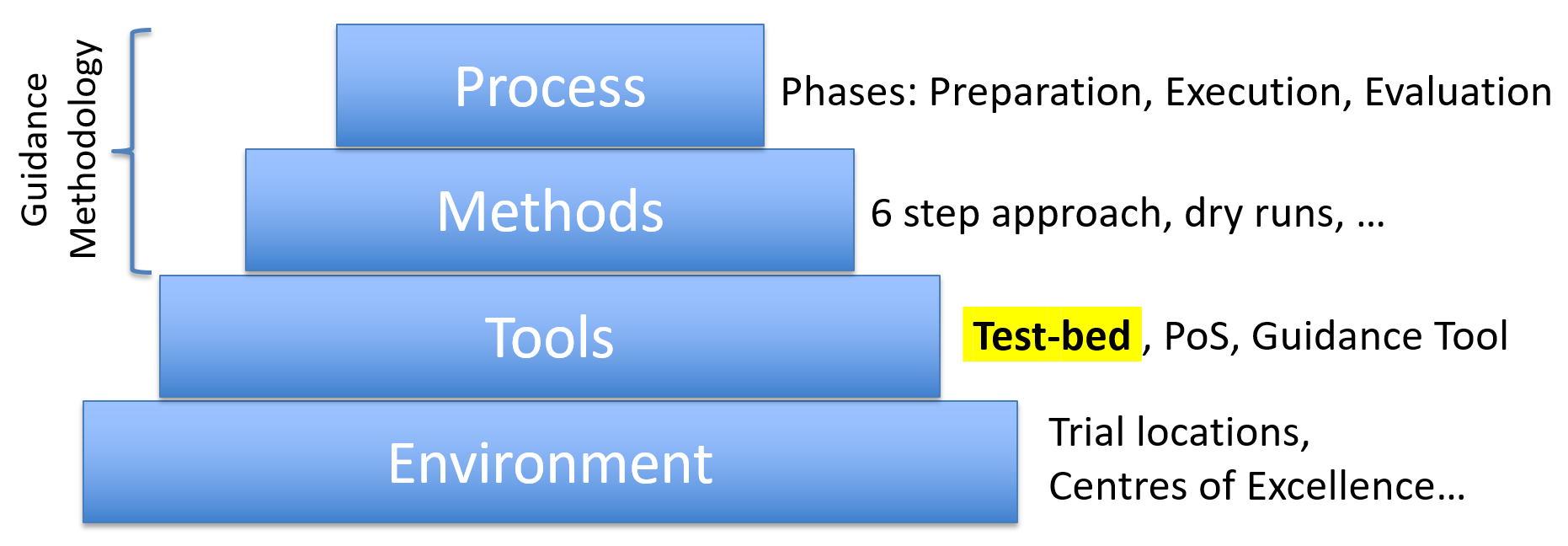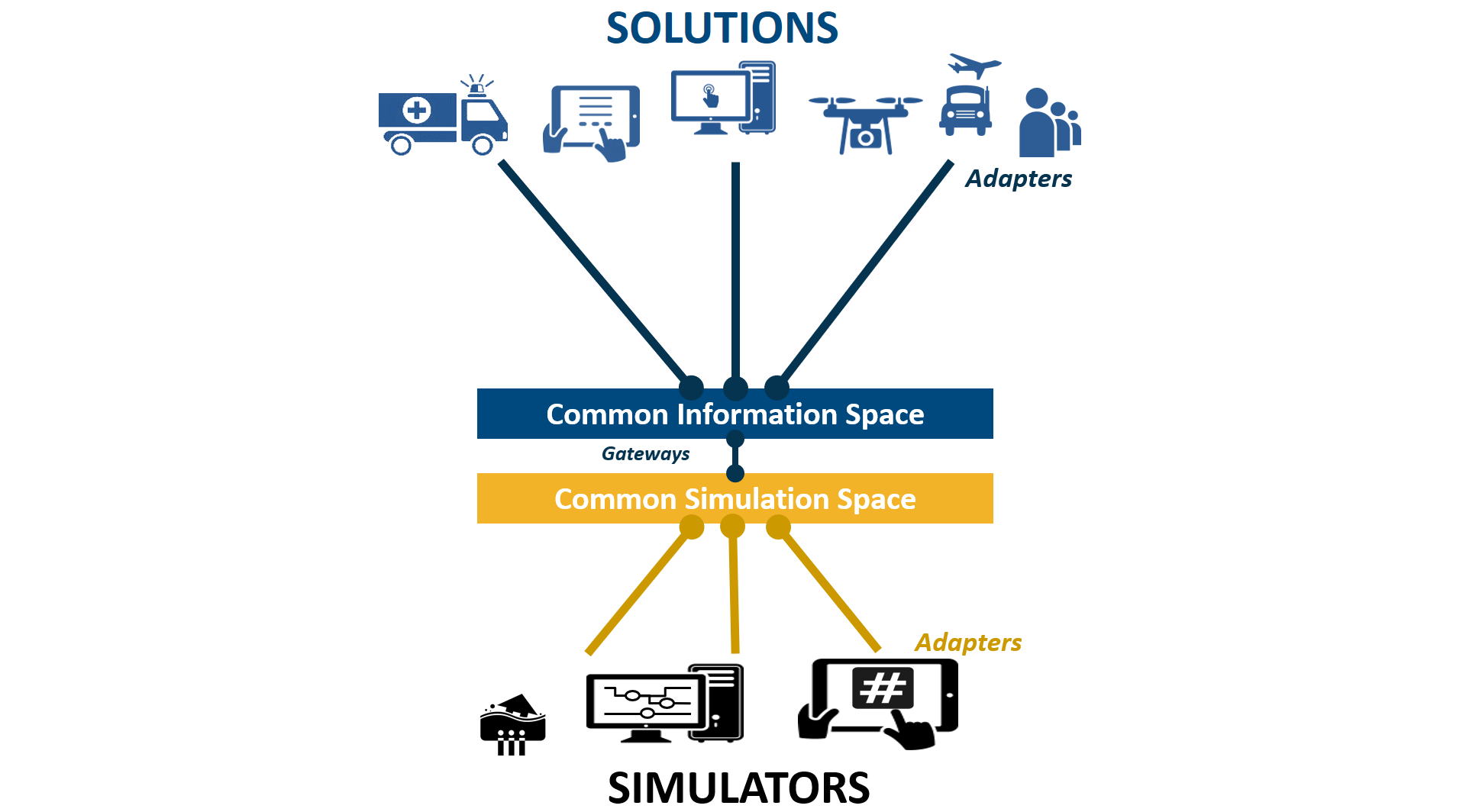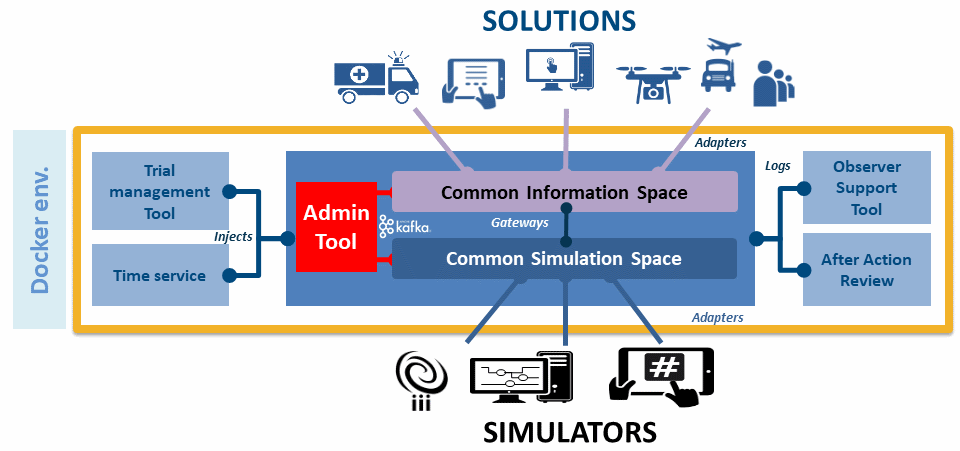Executive Summary
The Test-bed reference implementation lies at the heart of the trialling environment of the DRIVER+ project (see Figure 1 or visit the animation online at https://vimeo.com/299680658). It provides an open source technical backbone to perform Trials or exercises in a methodical and structured way by offering Crisis Management practitioners a suite of free and open source software tools. This document discusses the Test-bed's usage and design from the perspective of a practitioner. The later chapters, however, are aimed at developers and system administrators, and therefore assume that the reader has at least some technical background. In the DRIVER+ deliverable D923.11 "Functional specification of the Test-bed", the requirements of the Test-bed are documented. These requirements serve as basis for the design of the first release of the DRIVER+ Test-bed reference implementation as described in deliverable D923.21.
The current version of this document discusses the third version of the Test-bed reference implementation. Therefore, all returning readers are advised to read the change history carefully, as many parts of this document did not change.
The trial-oriented environment developed in sub-project 92 (Test-bed) of DRIVER+ is conceived and designed to allow systematic testing of solutions in realistic but non-operational contexts (namely, in Trials) to help practitioners in assessing solutions that can drive innovation (changes) before adopting them. See also deliverable D922.21, "Trial guidance methodology (TGM) and guidance tool specifications (version 1)".
The purpose of conducting Trials in DRIVER+ is to find out if and how some innovative solutions can help resolve the needs of Crisis Management practitioners.

The basic problem that the Test-bed reference implementation tries to solve is how to connect different solutions, which solve a particular Crisis Management (CM) gap, to:
- Each other: since no single application can solve all CM gaps, they need to work together by sharing information.
- One or more simulators: since during a Trial, you cannot start a real incident, there needs to be a way to simulate a realistic incident.
The main design decision is to connect solutions to a so-called Common Information Space (CIS), simulators to a Common Simulation Space (CSS), and to have gateway services in between that selectively allow some information to pass between the two spaces (see Figure 2). These spaces can be public or private, and allow applications to write messages to a topic of interest, or read those messages. Although both spaces are comparable in that they share well structured messages (using Apache AVRO) over a popular open source distributed messaging system, Apache Kafka, the separation allows for a better control of the message flow, and for replacing parts with an alternative implementation if needed.
In addition, several adapters are created to connect solutions and simulators to the CIS and CSS: besides allowing users of the Test-bed to choose an adapter in their favourite programming language, and share messages, it also provides a common interface for configuration, heartbeat messages, and security. Currently, adapters in Java, C#, JavaScript/TypeScript/NodeJS, Python and REST are available.

Around this core functionality, additional tools are developed that facilitate the usage of this environment (see Figure 3):
- Administrative tools: Is everyone up-and-running, secure, and connected to the right information topics?
- Evaluation tools: What did we observe during the Trial, and what implications does this have during the After-Action-Review.
- Scenario tools: To create an interesting scenario that triggers the participants and solutions in the right way.
- Support tools: For testing and debugging, for creating your personalized Test-bed environment, but also to share common data such as map layers or census data.

The Test-bed will be delivered in 3 versions. Version 1 is intended for use in Trials 1 and 2, and consists of a limited number of components (i.e. Trial-Management-Tool (TMT) and After-Action-Review (AAR) tool are not included and other components in first prototype quality). Version 2 was used in Trial 4 with a first version of the TMT and AAR, and the current version 3, as described in this document, will be used in Trial 3 and the Final Demo.
All software is already available open-source (under a liberal MIT license) on github.com/DRIVER-EU. The subsequent updated Test-bed reference implementations are documented in D923.21, D923.22, and D923.23 (this document) - Reference Implementations of the Test-bed (versions 1/2/3 resp.).
Besides the officially released software components, as described in the DRIVER+ DoW and in this document, the DRIVER-EU space on GitHub also contains many other useful services that were developed in order to support a Trial's specific needs. For example, Trial 4 required a deep integration between the Test-bed and the Dutch Crisis Management System (LCMS). This has led to a connector that extracts text and map overlays and vice versa. This connector is also being used in an upcoming table-top exercise (organised by the EU project IN-PREP) that is situated in The Netherlands, and will be supported in the future by the Dutch national CM CoE, IFV. Or on the simulator side, a connector with the open source SUMO traffic simulator was created, so future Trials or exercises can operate against a realistic traffic background, or use it for dispatching virtual ambulances. Other examples include the lesson's learned framework website, an icon and large file service, a geo-server that triggers when people or entities are at a certain location, an email gateway to add email services to the Test-bed, a Twitter service that sends messages to (preferably a private) twitter account, to name but a few. This document, however, focuses on the main deliverables needed to setup a Trial.
This document is a living document, and the latest version is available online at https://driver-eu.github.io/test-bed-design or can be downloaded as PDF, epub or mobi eBook 1.
1. Since the printed version is automatically generated from the online book, the template is slightly different from a Word-based version. It starts at a high-level with a description of the main components of the Test-bed reference implementation. Next, chapters are dedicated to the main users of this environment, practitioners and developers/ICT administrators. And it concludes with a brief explanation of the main design decisions. ↩